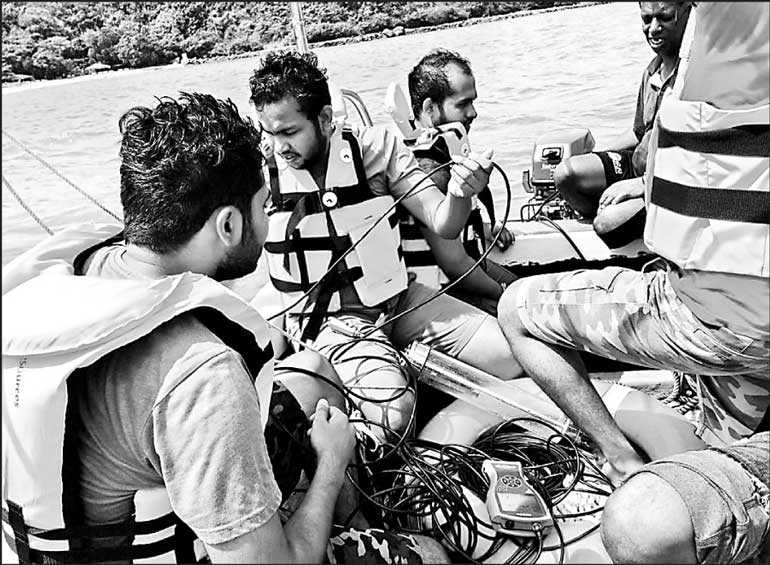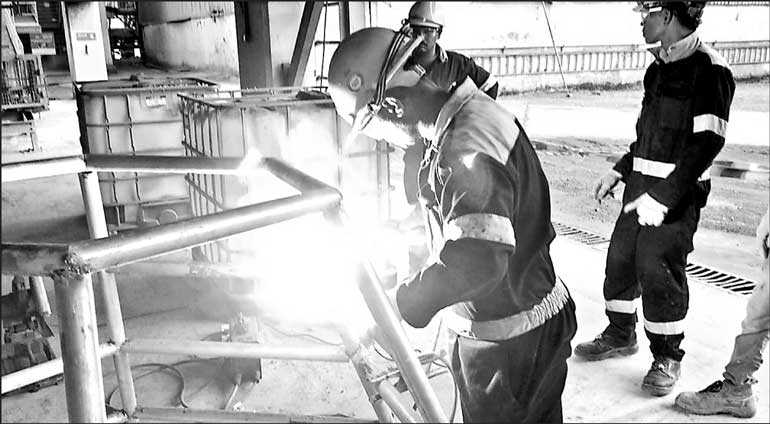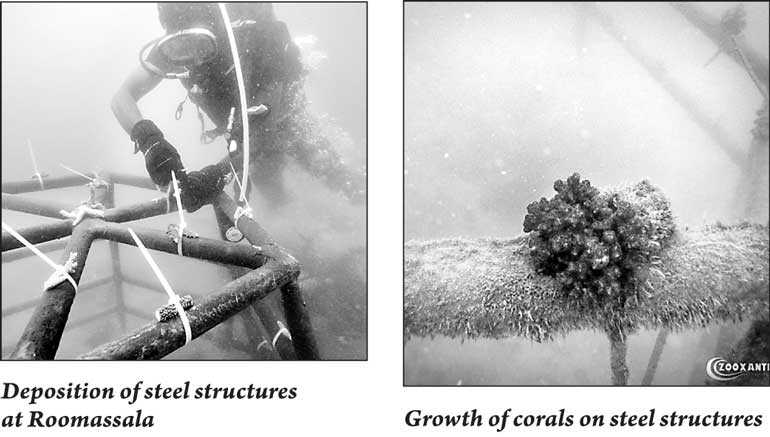Monday Mar 17, 2025
Monday Mar 17, 2025
Saturday, 1 June 2019 00:00 - - {{hitsCtrl.values.hits}}

Rotaractors conducting surveys to assess sea conditions

Construction of steel structures at Siam City Cement Lanka (Pvt) Ltd

Workshop for navy divers

The ocean beds surrounding our little island nation are filled with treasure. This treasure is not made of jewels, pearls, gold or silver; but of something far more valuable: Corals.
However, these treasures are being destroyed due to the careless and irrational actions of humans such as coral mining, sand mining, excessive fishing and dumping of garbage and waste-water to the ocean.
Rotaract Club of University of Moratuwa, sponsored by the Rotary Club of Colombo West, having perceived the need to protect this treasure beneath the ocean, embarked on a novel initiative of conserving them through its signature project, ‘Zooxanthellae’. In 2019, Rotary International chose Zooxanthellae as the Most Outstanding Rotaract Project in South Asia.
By now, you must be wondering: “What is the meaning of this very long word?” and “Why would anyone name a project ‘Zooxanthellae,’ which many of us find hard to even pronounce?”
As long as the name is, its meaning runs equally deep into the heart of the coral reefs. Zooxanthellae, more commonly known as “clades,” is a type of algae (microscopic living being) which lives on the surface of the corals. The existence and beauty of coral reefs are only possible because of the biological relationship between the corals and the Zooxanthellae, which provide the corals with energy, food and their vibrant colours.
Seeing that it is indeed these Zooxanthellae that breathe life into the beautiful coral reefs, the Rotaractors of University of Moratuwa thought it befitting to name its mission to save them as the same.
Then again, we have the question, “Why do we need to protect these corals?”, but what we don’t know is that these corals have been protecting us all these years. Coral reefs have the ability to absorb the energy from sea waves, hence slowing them down, resulting in the minimisation of coastal erosion, damage due to tides, storms, hurricanes, and even tsunamis. Coral reefs not only shelter oceanic ecosystems but also protect the flora and fauna along the coastal belt, including humans and homes.
Just last year, ‘Lonely Planet,’ one of the world’s largest travel guidebook publishers, ranked Sri Lanka as ‘The Top Country for Travel in 2019’ and according to survey statistics, the tourism industry in Sri Lanka has shown steady growth over the past decade. However, the tragic terrorist attacks on 21 April brought this growth to a standstill, as many tourists left the country following the attacks and others who had planned on visiting the island cancelled their bookings. But all hope is not lost!
This international award has opened eyes of many Rotarians around the globe about this tiny country and the beauty in our environment because the coasts and corals were always a major tourist attraction in Sri Lanka.
Zooxanthellae involved placing steel structures with live corals affixed to them on the seabed to stimulate coral growth and enhance the Zooxanthellae population. The Zooxanthellae project goes down in history as the first undertaking in Sri Lanka to do so by depositing steel structures. These structures act as a support for coral growth and enable them to develop into massive reefs which are expected to be a great asset to the tourism industry and the surrounding businesses.
However, these steel structures were not placed on the bed of the ocean overnight. The project started off as a coastal conservation endeavour in July 2016, when Rtr. Sahan Jayawardana, Director – Environment of Rotaract Mora at the time, suggested this initiative, following discussions with Prof. Nalin Ratnayake, oceanography expert from the Department of Earth Resources Engineering, University of Moratuwa.
The first step was finding a suitable location for coral rehabilitation and with the assistance, expertise and resources of the National Aquatic Resources Research & Development Agency (NARA); Jungle Beach, Rumassala, Galle was selected as the most suitable location.
Keeping the laws of the country, we are thankful to have received assistance from the Ministry of Defence Marine Environment Protection Authority (Departments of Coast Conservation and Wildlife Conservation) with regard to obtaining necessary clearance to conduct the project.
Many climatic factors such as temperature, turbidity, Secchi depth and nutrient content of water for optimal coral growth were checked on selecting the location followed by a socio-cultural analysis and economic background study regarding the coastal lifestyle of the surrounding area. It was gathered that many locals in the Rumassala area were engaged in tourism-related livelihood.
The steel structures were designed and produced with the sole sponsorship of Siam City Cement (Lanka) Ltd. under the constant supervision of Prof. Nalin Ratnayake and French marine biologists Thomas Lee Berre and Dr. Turney.
Amidst the designing stage of the 10 steel structures, wave power around the selected location as well as compulsory features to be possessed by the structures – such as ability to house marine life from large predators, sufficient height as not to be buried beneath the sea bed, adequate weight as not to be disturbed by the ocean waves and ability to withstand varying sea conditions to prevent dilapidation over time – were considered.
Prior to the deposition day of steel structures, an informative session was conducted by French marine biologist Thomas Le Barre and several Commanders from the Navy, to provide the diving crew of the Sri Lanka Navy the required technical knowledge and practical skills to attach branches of live corals to the steel structures and place them on the seabed.
The coral specimens were affixed to steel structures using cable-ties within one hour of obtaining them and the specimens were kept submerged through the entire process to sustain life within them. Finally, on 2 November 2018, 10 steel structures were successfully placed on the ocean bed and live coral specimens were attached to them underwater, with the guidance of a Marine Biologist from the Sri Lanka Navy.
The corals so deposited are under the strict supervision of the Sri Lanka Navy and it was confirmed by the Navy Commander that the corals were showing signs of growth several weeks subsequent to the deposition.
Emerging as the South Asia Regional Winner in Rotaract Outstanding Project Awards for the year 2018/19, Rotaract Mora has decided to extend a similar initiative of depositing steel structures towards the beautiful beaches of Trincomalee.
If you are interested in joining the next entrada, please email [email protected]. As the sun sets on the Rumassala shores and marine life sings in harmony to the melody of the waves, the Rotaractors of University of Moratuwa invite you to take a dive into the saltwater and witness the breathtaking corals in bloom.
– Thishani Wijayaratne
Zooxanthellae involved placing steel structures with live corals affixed to them on the seabed to stimulate coral growth and enhance the Zooxanthellae population. The Zooxanthellae project goes down in history as the first undertaking in Sri Lanka to do so by depositing steel structures. These structures act as a support for coral growth and enable them to develop into massive reefs which are expected to be a great asset to the tourism industry and the surrounding businesses
Discover Kapruka, the leading online shopping platform in Sri Lanka, where you can conveniently send Gifts and Flowers to your loved ones for any event including Valentine ’s Day. Explore a wide range of popular Shopping Categories on Kapruka, including Toys, Groceries, Electronics, Birthday Cakes, Fruits, Chocolates, Flower Bouquets, Clothing, Watches, Lingerie, Gift Sets and Jewellery. Also if you’re interested in selling with Kapruka, Partner Central by Kapruka is the best solution to start with. Moreover, through Kapruka Global Shop, you can also enjoy the convenience of purchasing products from renowned platforms like Amazon and eBay and have them delivered to Sri Lanka.
Discover Kapruka, the leading online shopping platform in Sri Lanka, where you can conveniently send Gifts and Flowers to your loved ones for any event including Valentine ’s Day. Explore a wide range of popular Shopping Categories on Kapruka, including Toys, Groceries, Electronics, Birthday Cakes, Fruits, Chocolates, Flower Bouquets, Clothing, Watches, Lingerie, Gift Sets and Jewellery. Also if you’re interested in selling with Kapruka, Partner Central by Kapruka is the best solution to start with. Moreover, through Kapruka Global Shop, you can also enjoy the convenience of purchasing products from renowned platforms like Amazon and eBay and have them delivered to Sri Lanka.